Biological Methods To Control Watermelon Pests and Diseases
- Biological Control
-
- Commodity name: Biological Methods To Control Watermelon Pests and Diseases
However, there is innumerable pests and diseases of watermelon that affect the yield and quality of watermelon for the growers. One of the most known plant pests is aphid, which feeds on plant sap and leads to dwarfism and viral diseases in the plants. Again, stink bugs affect fruits in the following ways; stink bugs lay their eggs on the fruits and once they hatch, they inject a hole with a slightly different coloration at the edges of the fruits. Other pests that affect this plant are cucumber beetles which feed on the leaves and the flowers spreading the bacterial wilt and the spider mites which turn yellow and cause the leaves to dry and the plant becomes weak.
On diseases the most devastating one is Fusarium Wilt which is a soil borne fungus that affects the vascular tissue of the plant, causing wilting and death of the plant. Downy mildew infects the whole plant as it covers a large area and inhibits photosynthesis while anthracnose is also a fungal disease that produces small elevated areas on leaves as well as fruits. This kind of fungus weakens plants because it forms powdery deposits on the surface of the leaves.
As for such worries, it is crucial to detect and respond to them effectively for watermelon producers. If pests and diseases are left uncontrolled then they can easily spread rapidly to severely affect yield and fruit quality. Plants or crops infected by pests also lead to loss as farmers cannot sell substandard products or even watermelons.
This also helps in prevention of these problems spreading to the next crops which would have resulted in more serious infection. Moreover, participating in solving these issues when they are manageable helps in encouraging sustainable farming since the growers can use the biological and organic ways to control the invasion before turning into a chemical control.
The other reason as to why there is a need to control and address promptly is to ensure that the fruits offered retain their quality. In severe cases, diseases or pests affect the appearance of the fruits and as a result they are unappetizing to consumers. This is because a timely intervention reduces the losses incurred on crops, the crops are healthier, and less severe pest or disease outbreaks occur in the future. Read to know the watermelon pest and diseases and their control methods.
Watermelon Pest
Watermelon Disease
Watermelon Nutrition
Watermelon Pest
If you are wondering as how to protect watermelon from pests, here is your answer-
Aphids, watermelon plant pests
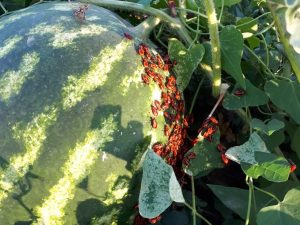
Features:
Aphids (Aphis gossypii, Myzus persicae) are small, soft-bodied insects that can infest a wide variety of crops, including watermelon. They are typically green, black, or brown, and can be winged or wingless. Aphids feed by inserting their needle-like mouthparts into plant tissue and sucking out the sap, which weakens the plant and stunts growth. They reproduce rapidly, and infestations can quickly grow in size.
Symptoms:
Signs of aphid infestation include curled, distorted, or yellowing leaves, as well as sticky honeydew secretions that can lead to sooty mold growth on the plant surfaces. Aphids often congregate on the undersides of leaves or at the growing tips of plants. In severe cases, plants may exhibit wilting, and fruit quality can be compromised. Additionally, aphids are known vectors for several plant viruses, which can cause further damage to the crop.
Management:
Effective aphid management begins with regular monitoring. Inspect the undersides of leaves and the growing tips of plants for early signs of aphids. Encourage natural predators such as ladybugs, lacewings, and predatory wasps, which feed on aphids. Introducing or conserving these beneficial insects can significantly reduce aphid populations. Insecticidal soaps or neem oil can be used to watermelon pest control without harming beneficial insects. In cases of severe infestation, selective insecticides may be necessary, but these should be used sparingly to minimize the impact on non-target species and prevent resistance. Implementing an integrated pest management (IPM) approach that combines these strategies can effectively manage aphids in watermelon crops.
Solution:
To manage aphids naturally, consider using Beveria WP, a biological insecticide from Novobac. This product contains the fungus Beauveria bassiana, which infects and kills aphids by penetrating their outer layer. By applying Beveria WP, you not only reduce aphid populations but also protect beneficial insects, ensuring a healthier garden without relying on chemical pesticides.
Spider Mites

Features:
Spider Mites, particularly the Two-Spotted Spider Mite (Tetranychus urticae), are tiny arachnids that can cause significant damage to watermelon plants. These pests thrive in hot, dry conditions and are often found on the undersides of leaves. Spider mites feed by piercing plant cells and sucking out the contents, leading to a stippling effect on the leaves. They reproduce quickly, and their populations can explode under favorable conditions, causing widespread damage.
Symptoms:
Symptoms of spider mite infestation include tiny, white or yellow speckles on leaves, known as stippling. As feeding continues, leaves may become bronze or yellow and eventually fall off. Heavy infestations can lead to significant defoliation, reducing photosynthetic capacity and ultimately affecting fruit yield and quality. Spider mites also produce fine webbing on the undersides of leaves or between stems, which can be a telltale sign of their presence.
Management:
Effective management of spider mites involves regular monitoring and early detection. Inspect the undersides of leaves frequently, especially during hot, dry weather. Encourage natural predators such as predatory mites, ladybugs, and lacewings, which feed on spider mites. Miticides may be necessary in severe infestations, but these should be used with caution to avoid harming beneficial insects and causing resistance development. Increasing humidity around plants by watering or misting can also help reduce mite populations, as they prefer dry conditions. An IPM approach that combines cultural practices, biological control, and targeted chemical treatments is essential for managing spider mites in watermelon crops.
Solution:
For watermelon pest control spider mites effectively and sustainably, use Beveria WP from Novobac. This biological insecticide contains Beauveria bassiana, a fungus that infects and kills spider mites upon contact. By applying Beveria WP, you can naturally manage spider mite populations while safeguarding your plants, without the use of harsh chemical pesticides.
Whiteflies
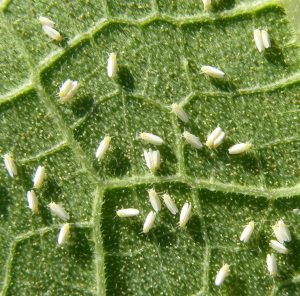
Features:
Whiteflies, particularly the Silverleaf Whitefly (Bemisia tabaci), are small, winged insects that feed on watermelon plants by sucking sap from the underside of leaves. These pests are typically white or pale yellow and are known for their ability to rapidly develop large populations, especially in warm, humid environments. Whiteflies can weaken plants, reduce growth, and transmit several plant viruses, posing a dual threat to watermelon crops.
Symptoms:
Signs of whitefly infestation include yellowing and wilting of leaves, as well as the presence of sticky honeydew on leaf surfaces. This honeydew can lead to sooty mold growth, further reducing the plant’s photosynthetic ability. Infested plants may also exhibit stunted growth and reduced fruit quality. Whiteflies are also vectors for several plant viruses, including the Cucurbit Yellow Stunting Disorder Virus (CYSDV), which can cause additional damage to crops.
Management:
Managing whiteflies in watermelon involves regular monitoring and a combination of control strategies. Use yellow sticky traps to monitor and reduce whitefly populations. Encourage natural enemies like predatory beetles, lacewings, and parasitic wasps, which feed on whiteflies and help maintain their populations. Insecticidal soaps and oils can be effective in reducing whitefly numbers without harming beneficial insects. In cases of heavy infestations, targeted insecticide applications may be necessary, but these should be used cautiously to prevent resistance development. Implementing an IPM strategy that integrates cultural, biological, and chemical controls is the most effective way to manage whiteflies in watermelon crops.
Solution:
For watermelon pest control whiteflies naturally, Novobac’s Beveria WP offers an effective solution. This biopesticide, powered by the fungus Beauveria bassiana, targets and infects whiteflies, eventually killing them while leaving no harmful residues. By using Beveria WP, you can manage whiteflies sustainably, safeguarding your watermelon plants without resorting to chemical insecticides.
Cucumber Beetles
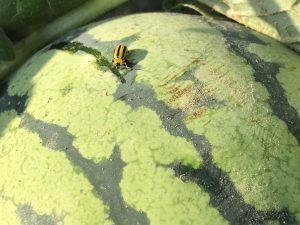
Features:
Cucumber Beetles, such as the Striped Cucumber Beetle (Acalymma vittatum) and the Spotted Cucumber Beetle (Diabrotica undecimpunctata), are common pests of watermelon and other cucurbits. These beetles are about 0.25 inches long and are easily recognized by their distinctive black and yellow or green stripes or spots. Both adults and larvae cause damage to watermelon plants, with adults feeding on leaves, flowers, and stems, while larvae feed on roots.
Symptoms:
Cucumber Beetle damage manifests as small holes or ragged edges on leaves and flowers, which can reduce photosynthetic capacity and plant vigor. The beetles also feed on stems, which can lead to wilting and collapse of young seedlings. Larvae feeding on roots can weaken plants, making them more susceptible to other pests and diseases. Moreover, cucumber beetles are known vectors for bacterial wilt, a serious disease that can further devastate watermelon crops.
Management:
Managing cucumber beetles requires a multi-faceted approach. Monitor plants regularly for early signs of beetle activity, particularly during the seedling stage when plants are most vulnerable. Use row covers to protect young plants from beetle feeding, removing them once plants begin to flower. Sticky traps and pheromone traps can help reduce beetle populations. Apply insecticides if beetle populations reach damaging levels, using selective products to minimize harm to beneficial insects. Encourage natural predators, such as ground beetles and parasitic wasps, to help control cucumber beetle populations. An IPM approach that integrates these cultural, biological, and chemical controls is the most effective strategy for managing cucumber beetles in watermelon crops.
Solution:
A natural and effective way to combat cucumber beetles is by using Myco Pestop, a biological insecticide from Novobac. Myco Pestop is based on Metarhizium anisopliae, a beneficial fungus that infects and kills cucumber beetles. By applying Myco Pestop, you not only target the beetles but also promote long-term pest control, reducing the need for chemical insecticides and ensuring healthier watermelon crops.
Squash Bugs
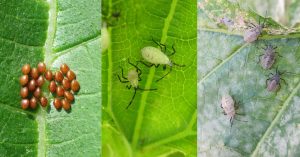
Features:
Squash Bugs (Anasa tristis) are a significant pest of watermelon and other cucurbits. These insects are shield-shaped, about 0.75 inches long, and are typically brown or gray. Squash bugs feed by piercing plant tissues and sucking out the sap, which weakens the plant and can lead to wilting and death. They are most active in warm, dry conditions and can cause significant damage if not managed properly.
Symptoms:
Signs of squash bug infestation include yellowing and wilting of leaves, particularly around the feeding sites. The bugs often congregate at the base of the plant, causing damage to stems and crowns, which can lead to plant collapse. Heavy infestations can result in significant defoliation, reduced fruit quality, and lower yields. Squash bugs also excrete a toxin while feeding, which can cause further damage to the plant tissues.
Management:
Effective management of squash bugs involves regular monitoring and early intervention. Inspect plants regularly for signs of squash bugs, especially during the early morning or late afternoon when they are most active. Remove and destroy eggs and nymphs by hand to reduce future populations. Use floating row covers to protect young plants from squash bug feeding. Encourage natural predators, such as spiders and predatory beetles, to help control squash bug populations. In severe cases, insecticides may be necessary, but they should be used sparingly to avoid harming beneficial insects. An IPM approach that incorporates these cultural, biological, and chemical control measures is crucial for managing squash bugs in watermelon crops.
Solution:
To control squash bugs effectively, you can use Beveria WP from Novobac. This biological insecticide contains the fungus Beauveria bassiana, which targets squash bugs by infecting them and causing death from within. By applying Beveria WP, you can manage squash bug infestations naturally, protecting your watermelon crops without harmful chemical pesticides, and promoting a healthier garden environment.
Leaf Miners
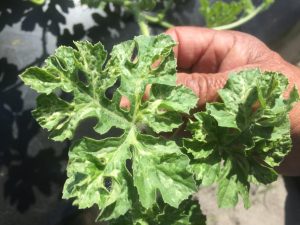
Features:
Leaf Miners, primarily from the genus Liriomyza, are small, yellow and black flies whose larvae cause damage to watermelon plants by burrowing into leaves. The larvae feed on the tissue between the upper and lower surfaces of the leaf, creating winding tunnels or “mines” that can reduce photosynthetic capacity and overall plant vigor. Leaf miners are most active in warm weather and can cause significant damage if left unchecked.
Symptoms:
The most noticeable symptoms of leaf miner infestation are the winding, serpentine mines on the leaves. These mines appear as white or pale yellow trails that eventually turn brown as the tissue dies. Severe infestations can cause extensive leaf damage, reducing photosynthetic capacity and leading to stunted plant growth and reduced fruit yield. The presence of leaf mines also makes the plants more susceptible to other pests and diseases.
Management:
Managing leaf miners involves a combination of monitoring and control strategies. Regularly inspect plants for early signs of leaf mines and remove and destroy affected leaves to reduce larval populations. Encourage natural predators, such as parasitic wasps and predatory beetles, which feed on leaf miner larvae and help keep their populations in check. Use insecticidal sprays that target larvae within the leaves, but avoid broad-spectrum insecticides that can harm beneficial insects. Implement cultural practices, such as crop rotation and removing plant debris, to reduce overwintering sites for adult flies. An IPM approach that integrates these cultural, biological, and chemical controls is essential for managing leaf miners in watermelon crops.
Solution:
To effectively control Leaf Miners, consider using BT Thuricide from Novobac, an organic insecticide containing Bacillus thuringiensis. This naturally occurring bacterium targets the larvae of Leaf Miners, killing them after ingestion. By applying BT Thuricide, you protect your watermelon crops from further damage without harming beneficial insects, ensuring a safe and chemical-free solution for your garden.
Cutworms
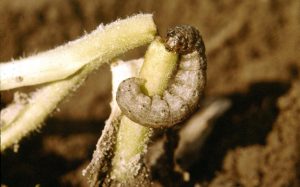
Features:
Cutworms, including species such as Agrotis ipsilon (Black Cutworm) and Peridroma saucia (Variegated Cutworm), are nocturnal caterpillars that feed on the stems and roots of young watermelon plants. These pests are most active at night and can cause significant damage by cutting down seedlings at the soil line, leading to plant death. Cutworms are most problematic in fields with abundant organic matter or weeds, which serve as shelter and food sources for the larvae.
Symptoms:
Symptoms of cutworm damage are typically visible in the early morning, with young seedlings cut off at or just below the soil line. In some cases, cutworms may also feed on roots, resulting in wilting and plant death. Affected fields often have scattered patches of dead or missing plants, which can reduce overall crop stand and yield. The presence of cutworms can also lead to uneven plant growth, affecting fruit development and quality.
Management:
Effective cutworm management involves a combination of cultural and chemical controls. Regularly monitor fields for signs of cutworm activity, particularly in newly planted areas. Use physical barriers, such as collars around young plants, to protect them from cutworm feeding. Remove weeds and crop debris from fields to reduce cutworm habitats. Apply insecticides as a soil drench around the base of plants to target larvae. Timing is crucial, as treatments are most effective when larvae are small and actively feeding. Encourage natural predators, such as birds, to help control cutworm populations. An IPM approach that integrates these strategies is the most effective way to manage cutworms in watermelon crops.
Solution:
A sustainable solution to combat cutworms is using MET Zone, a biological insecticide from Novobac. It contains the beneficial fungus Metarhizium anisopliae, which infects and kills cutworms by growing inside them. Applying MET Zone offers an eco-friendly approach to managing cutworms, protecting your watermelon crop while promoting a balanced ecosystem without the need for harmful chemicals.
Thrips

Features:
Thrips, such as Thrips tabaci and Frankliniella occidentalis, are tiny, slender insects that feed on watermelon plants by piercing and sucking sap from the leaves, flowers, and fruit. They are most problematic in warm, dry conditions and can cause significant damage to watermelon crops. Thrips are also vectors for several plant viruses, including Tomato Spotted Wilt Virus (TSWV), which can further impact crop yield and quality.
Symptoms:
Symptoms of thrips infestation include silvering or bronzing of leaves due to their feeding, which reduces photosynthetic capacity and weakens the plant. Infested flowers may become deformed, leading to poor fruit set. On fruit, thrips feeding can cause scarring and discoloration, reducing marketability. In severe cases, the plant may exhibit stunted growth and reduced yield due to thrips feeding and virus transmission.
Management:
Effective management of thrips involves regular monitoring and a combination of cultural, biological, and chemical controls. Inspect plants regularly for signs of thrips activity, particularly during hot, dry weather. Encourage natural predators, such as predatory mites and lacewings, which feed on thrips and help keep their populations in check. Use insecticidal soaps or neem oil to reduce thrips numbers without harming beneficial insects. In severe infestations, targeted insecticide applications may be necessary, but these should be used judiciously to prevent resistance development. Implementing an IPM strategy that integrates these methods is essential for managing thrips in watermelon crops.
Solution:
To naturally control these pests, use Beveria WP, a biological insecticide from Novobac. Beveria WP contains the fungus Beauveria bassiana, which infects and destroys thrips by invading their bodies. By applying Beveria WP, you effectively reduce thrips populations while safeguarding beneficial organisms, all without the need for harsh chemical insecticides, ensuring a more resilient crop.
Melon Worm
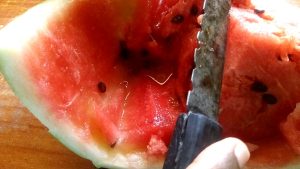
Features:
The Melon Worm (Diaphania hyalinata) is a caterpillar that feeds on the leaves and fruit of watermelon and other cucurbits. The larvae are pale green with a distinct white stripe running down each side of their bodies. Melon worms can cause significant defoliation and fruit damage if not controlled, particularly in warm, humid conditions.
Symptoms:
Symptoms of melon worm infestation include holes and ragged edges on leaves, as well as damage to flowers and young fruit. The larvae feed on the flesh of the fruit, causing deep cavities that can lead to secondary infections and rot. In severe cases, melon worms can defoliate plants entirely, reducing photosynthetic capacity and yield. Infested fruit is often unmarketable due to the damage caused by feeding.
Management:
Managing melon worms requires a combination of monitoring and control strategies. Regularly inspect plants for signs of melon worm activity, particularly during periods of high humidity. Use pheromone traps to monitor adult moth populations and apply insecticides when necessary to control larvae. Encourage natural predators, such as parasitic wasps and predatory beetles, which feed on melon worm larvae. Remove and destroy infested fruit and foliage to reduce pest populations. An IPM approach that integrates these cultural, biological, and chemical controls is essential for managing melon worms in watermelon crops.
Solution:
A natural way to combat Melon Worms is by using BT Thuricide from Novobac. This biological insecticide contains Bacillus thuringiensis, a bacterium that specifically targets caterpillars like Melon Worms, paralyzing their digestive system and ultimately eliminating them. By applying BT Thuricide, you protect your watermelon plants effectively, reducing damage without the need for chemical pesticides, keeping your harvest healthy and safe.
Flea Beetles, watermelon plant pests

Features:
Flea Beetles, such as Epitrix spp., are small, jumping beetles that feed on the leaves of watermelon plants, causing characteristic shot-hole damage. These pests are most active in warm, dry conditions and can cause significant damage to seedlings and young plants, reducing overall plant vigor and yield.
Symptoms:
Symptoms of flea beetle infestation include small, round holes or pits in the leaves, giving them a shot-hole appearance. Severe infestations can lead to reduced photosynthetic capacity, stunted growth, and poor fruit development. Flea beetles can also transmit bacterial wilt, a serious disease that can further reduce crop yield and quality.
Management:
Effective management of flea beetles involves regular monitoring and a combination of cultural and chemical controls. Inspect plants regularly for signs of flea beetle activity, particularly during the seedling stage when plants are most vulnerable. Use row covers to protect young plants from flea beetle feeding, removing them once plants begin to flower. Apply insecticides if flea beetle populations reach damaging levels, using selective products to minimize harm to beneficial insects. Encourage natural predators, such as ground beetles and parasitic wasps, to help control flea beetle populations. An IPM approach that integrates these methods is essential for managing flea beetles in watermelon crops.
Solution:
A natural way to control flea beetles on watermelon is by using Myco Pestop, an organic insecticide from Novobac. Myco Pestop contains the beneficial fungus Metarhizium anisopliae, which targets and infects flea beetles, disrupting their lifecycle. By applying Myco Pestop, you effectively manage flea beetle populations and protect your watermelon plants without resorting to chemical insecticides, promoting healthier growth and fruit production.
Armyworms
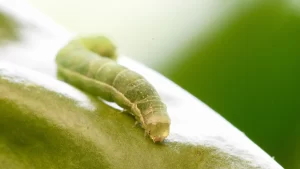
Features:
Armyworms, including species such as Spodoptera spp., are caterpillar pests that feed on the leaves and fruit of watermelon plants. These pests are most active at night and can cause significant damage to crops, particularly in warm, humid conditions. Armyworms are most problematic in fields with abundant organic matter or weeds, which serve as shelter and food sources for the larvae.
Symptoms:
Symptoms of armyworm infestation include ragged holes in leaves, defoliation, and damage to fruit. The larvae feed on the flesh of the fruit, causing deep cavities that can lead to secondary infections and rot. In severe cases, armyworms can defoliate plants entirely, reducing photosynthetic capacity and yield. Infested fruit is often unmarketable due to the damage caused by feeding.
Management:
Managing armyworms requires a combination of monitoring and control strategies. Regularly inspect plants for signs of armyworm activity, particularly during periods of high humidity. Use pheromone traps to monitor adult moth populations and apply insecticides when necessary to control larvae. Encourage natural predators, such as parasitic wasps and predatory beetles, which feed on armyworm larvae. Remove and destroy infested fruit and foliage to reduce pest populations. An IPM approach that integrates these cultural, biological, and chemical controls is essential for managing armyworms in watermelon crops.
Solution: A natural and effective solution to control armyworms is BT Thuricide from Novobac. This organic insecticide uses Bacillus thuringiensis (Bt), a bacterium that targets armyworms by releasing toxins that disrupt their digestive system. Once applied, BT Thuricide helps to eliminate armyworms without harming beneficial insects or pollinators, offering a safe and eco-friendly way to protect your watermelon plants from these pests.
Wireworms, watermelon plant pests
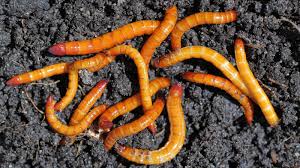
Features:
Wireworms, the larval stage of click beetles (Agriotes spp., Melanotus spp.), are soil-dwelling pests that feed on the roots and stems of watermelon plants. These pests are most problematic in fields with a history of wireworm infestations, particularly in sandy soils. Wireworms can cause significant damage to crops, particularly during the seedling stage.
Symptoms:
Symptoms of wireworm infestation include poor germination, seedling collapse, and stunted growth. The larvae feed on the roots and stems of young plants, causing wilting and death. Affected fields often have scattered patches of dead or missing plants, reducing overall crop stand and yield. The presence of wireworms can also lead to uneven plant growth, affecting fruit development and quality.
Management:
Effective management of wireworms involves a combination of cultural, chemical, and biological practices. Rotate crops with non-host plants to reduce wireworm populations in the soil. Use resistant varieties when available and improve soil health with organic amendments, such as compost or cover crops, to enhance beneficial microbial activity. Soil solarization can help reduce wireworm populations by heating the soil to lethal temperatures. Chemical insecticides can be effective but should be used as part of an IPM strategy that integrates cultural and biological controls for sustainable management.
Solution:
To control wireworms naturally, you can use MET Zone from Novobac, a biological solution based on the entomopathogenic fungus Metarhizium anisopliae. MET Zone targets wireworms by infecting them with fungal spores, which ultimately kill the larvae without harming the surrounding environment. This eco-friendly approach ensures your watermelon plants stay healthy and productive without the need for harsh chemicals.
Root Maggots
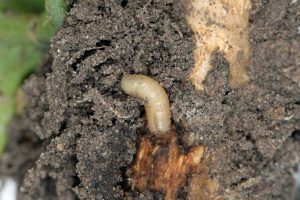
Features:
Root Maggots, primarily Delia spp., are small, white larvae that feed on the roots of watermelon plants, causing significant damage and yield loss. These pests are most problematic in cool, wet conditions and can affect seedlings both before and after emergence.
Symptoms:
Symptoms of root maggot infestation include poor germination, seedling collapse, and stunted growth. The larvae feed on the roots, causing them to become brown and mushy. Affected plants often exhibit wilting, yellowing, and reduced vigor, particularly during hot weather. In severe cases, entire plants may die.
Management:
Managing root maggots requires a combination of cultural, chemical, and biological practices. Rotate crops with non-host plants to reduce root maggot populations in the soil. Use resistant varieties when available and improve soil health with organic amendments, such as compost or cover crops, to enhance beneficial microbial activity. Apply insecticides as a soil drench around the base of plants to target larvae. Encourage natural predators, such as birds, to help control root maggot populations. An IPM approach that integrates these strategies is essential for managing root maggots in watermelon crops.
Solution:
To protect your watermelon crops naturally, consider using MET Zone from Novobac. This bioinsecticide contains Metarhizium anisopliae, a beneficial fungus that targets and infects root maggots, ultimately killing them. By applying MET Zone, you can control root maggot infestations, safeguarding your plants and promoting healthier root systems without resorting to chemical treatments.
Stink Bugs
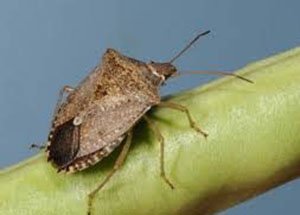
Features:
Stink Bugs, such as Nezara viridula and Euschistus servus, are shield-shaped insects that feed on watermelon plants by piercing plant tissues and sucking out the sap. These pests are most active in warm, dry conditions and can cause significant damage if not managed properly.
Symptoms:
Signs of stink bug infestation include yellowing and wilting of leaves, particularly around the feeding sites. The bugs often congregate at the base of the plant, causing damage to stems and crowns, which can lead to plant collapse. Heavy infestations can result in significant defoliation, reduced fruit quality, and lower yields. Stink bugs also excrete a toxin while feeding, which can cause further damage to the plant tissues.
Management:
Effective management of stink bugs involves regular monitoring and early intervention. Inspect plants regularly for signs of stink bugs, especially during the early morning or late afternoon when they are most active. Remove and destroy eggs and nymphs by hand to reduce future populations. Use floating row covers to protect young plants from stink bug feeding. Encourage natural predators, such as spiders and predatory beetles, to help control stink bug populations. In severe cases, insecticides may be necessary, but they should be used sparingly to avoid harming beneficial insects. An IPM approach that incorporates these cultural, biological, and chemical control measures is crucial for managing stink bugs in watermelon crops.
Solution:
A sustainable way to manage Stink Bugs is by using Beveria WP from Novobac. This organic biopesticide contains the fungus Beauveria bassiana, which infects and kills Stink Bugs by invading their body and stopping their feeding. By applying Beveria WP, you effectively control Stink Bug infestations while maintaining the health of your watermelon plants, without the need for chemical solutions.
Watermelon Disease
Fusarium Wilt
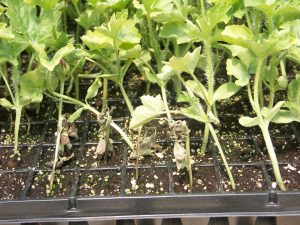
Features:
Fusarium Wilt (Fusarium oxysporum f. sp. niveum) is a fungal disease that affects watermelon and results in lose production of the fruit. The fungus can be found in the soil and enters the plant through the root system. This fungus thrives in warm weather and may survive in the soil for years. The pathogen infects the vascular tissue of the plant thus inhibiting the flow of water that results to wilting the plants and finally death of the plant.
Symptoms:
Fusarium Advanced is characterized by yellowing of the aerial parts of the plant starting with the old ones, followed by the young ones. Stem lesions may be initially limited to a small area and extend upward and downward over time, turn dark brown to black, and become slightly raised Lesions may become necrotic causing leaves to wilt during the day and perhaps even recover at night; finally, some may become permanently wilted and turn brown. It can be known from the infected plant that the developed cuts in stems show dark-brown linear streaks in the vascular system area. These effects may include stunted growth in some plants and low yields and low quality of fruits in the affected plants.
Management:
There are various measures that are taken to Control Fusarium Wilt. As a result of this, a cropping system with non-host crops is recommended in this study to minimize the population of the pathogen in the soil. Current losses can thus be reduced through growing resistant watermelon varieties. It has been recommended that, to reduce the likelihood of disease spread, crop debris on farms that harbor the pathogen must be physically cleared and burned. Other control methods include: Soil solarization – a technique of heating the soil to high temperatures with the aid of a plastic cover is also effective in reducing fungal numbers. There are biological control measures that can be applied in the control of this fungus and these are through the introduction of friendly soil microbes that are effective in controlling the growth of the fungus. As mentioned earlier, fungicide treatments do not work if disease is already present and therefore prevention is critical through use of proper agronomic practices and resistant varieties. Use of these methods in combination with an Integrated Pest Management (IPM) strategy is suggested to combat Fusarium Wilt in watermelons.
Solution:
Fusarium Wilt is a serious fungal disease that threatens the vitality of many crops, causing yellowing, wilting, and eventual plant death by attacking the vascular system. To combat this issue effectively, the application of Trianum Shield, a bio-fungicide based on the beneficial fungus Trichoderma harzianum, is recommended. This biofungicide works by colonizing the root zone, acting as a shield that suppresses Fusarium pathogens while promoting healthier plant growth. Trianum Shield aids in the biological control of Fusarium Wilt without the need for harsh chemical fungicides, fostering a more resilient and thriving crop environment.
Anthracnose Watermelon Disease
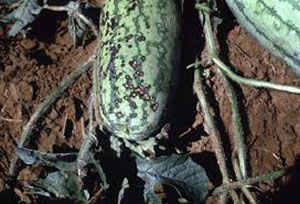
Features:
Anthracnose, caused by the fungus Colletotrichum lagenarium, is a severe disease affecting watermelon crops worldwide. This fungus thrives in warm, wet conditions and primarily attacks leaves, stems, and fruit. The pathogen overwinters in infected plant debris and seeds, making sanitation and seed selection critical components of management. Spores are spread by rain splash, wind, and insects, quickly leading to widespread infections if not controlled.
Symptoms:
Symptoms of Anthracnose on watermelon begin as small, circular, water-soaked lesions on the leaves. These lesions eventually turn dark brown or black with a yellow halo, leading to premature leaf drop and defoliation. On stems and fruit, the lesions appear sunken and can become covered with pinkish spore masses under moist conditions. Infected fruit often exhibit soft, sunken spots that eventually rot, rendering them unmarketable. The disease severely affects fruit quality and yield, particularly in fields with a history of Anthracnose or during prolonged wet conditions.
Management:
Managing Anthracnose requires an integrated approach. Start with selecting resistant watermelon varieties and planting certified disease-free seeds. Crop rotation with non-cucurbit crops helps reduce pathogen build-up in the soil. Ensure proper field sanitation by removing and destroying infected plant debris and weeds that may harbor the fungus. Regular monitoring and early detection are crucial for timely intervention. Fungicide applications, especially during periods of high humidity and rainfall, can be effective but should be rotated with different modes of action to prevent resistance development. Improving air circulation through proper plant spacing and trellising can reduce humidity levels, making the environment less favorable for disease development. An integrated pest management (IPM) approach combining these strategies is the most effective way to manage Anthracnose in watermelon crops.
Solution:
Anthracnose is a destructive fungal disease that affects a wide variety of crops, leading to dark lesions, fruit rot, and defoliation, which can significantly reduce yield. A sustainable and effective solution to this issue is the use of Trianum V, a bio-fungicide formulated with Trichoderma harzianum. This beneficial fungus naturally competes with harmful pathogens like those causing Anthracnose, enhancing the plant’s natural defenses and promoting root health. By applying Trianum V, you protect your crops from the damaging effects of Anthracnose, ensuring a healthier harvest without resorting to chemical fungicides.
Downy Mildew Watermelon disease

Features:
Downy Mildew, caused by the oomycete Pseudoperonospora cubensis, is a significant disease affecting watermelon and other cucurbits. This pathogen thrives in cool, moist conditions and can spread rapidly through wind-borne spores. The disease primarily affects the leaves, reducing photosynthetic capacity and, consequently, fruit yield and quality. Downy Mildew is particularly problematic in areas with frequent rainfall or heavy dew.
Symptoms:
Symptoms of Downy Mildew on watermelon start as pale green to yellow angular spots on the upper leaf surfaces, which are limited by leaf veins. These spots become necrotic over time, turning brown and causing leaf curling and death. The undersides of infected leaves often display a downy, grayish fungal growth, particularly under humid conditions. As the disease progresses, significant defoliation can occur, leading to sunburned fruit and reduced yield.
Management:
Effective management of Downy Mildew includes regular monitoring and early detection. Use resistant varieties when available, as they can significantly reduce disease incidence and severity. Improve air circulation within the canopy through proper spacing and pruning to reduce humidity levels around the plants. Fungicide applications can help manage Downy Mildew, especially during periods of favorable weather conditions for the pathogen. Rotate fungicides with different modes of action to avoid resistance development. Irrigate plants in the morning to allow foliage to dry quickly and reduce the likelihood of infection. Implementing an IPM strategy that includes these cultural, biological, and chemical control measures is critical to managing Downy Mildew in watermelon crops effectively.
Solution:
Downy Mildew is a highly problematic disease that manifests as yellow patches and fuzzy mold on the underside of leaves, often leading to stunted growth and reduced yields. To tackle this disease effectively, the use of Trianum-V, a bio-fungicide containing the beneficial fungus Trichoderma harzianum, is highly recommended. This foliar spray works by colonizing the plant surface, outcompeting the Downy Mildew pathogen, and enhancing the plant’s resistance to infection. By using Trianum-V, you can safeguard your crops from Downy Mildew while promoting overall plant vitality, all without the need for chemical fungicides.
Powdery Mildew
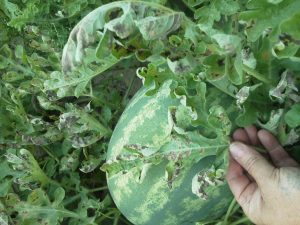
Features:
Powdery Mildew, caused by the fungi Erysiphe cichoracearum and Sphaerotheca fuliginea, is a common disease affecting watermelon and other cucurbits. Unlike other fungal diseases that require high humidity to thrive, Powdery Mildew can develop under drier conditions, making it a persistent problem in many growing regions. The disease primarily affects the leaves, covering them with a white, powdery fungal growth that reduces photosynthetic ability and weakens the plant.
Symptoms:
The initial symptoms of Powdery Mildew are small, white, powdery spots on the upper surfaces of leaves. These spots gradually expand, covering large areas of the leaf surface. As the disease progresses, the infected leaves turn yellow, become brittle, and may curl or die prematurely. In severe cases, the plant’s overall growth is stunted, and fruit yield is reduced. The disease is most problematic late in the growing season when conditions are more favorable for its spread.
Management:
Managing Powdery Mildew effectively involves using resistant watermelon varieties whenever possible. Regularly inspect plants for early signs of infection, particularly during dry periods when the disease is most likely to appear. Remove and destroy infected leaves to reduce the spread of the disease. Apply fungicides as needed, rotating different modes of action to prevent resistance development. Cultural practices, such as ensuring proper plant spacing to improve air circulation, can also help reduce the humidity around leaves and minimize infection risk. An integrated pest management (IPM) approach combining these methods is the best strategy for managing Powdery Mildew in watermelon crops.
Solution:
Powdery Mildew is a common yet serious fungal disease that causes white, powdery spots on leaves, stems, and fruits, leading to distorted growth and reduced crop yield. A practical and eco-friendly solution is the application of Trianum-V, a bio-fungicide that contains the beneficial fungus Trichoderma harzianum. This foliar spray effectively protects plants by creating a protective layer on the leaves, suppressing the Powdery Mildew spores, and boosting the plant’s immune response. Using Trianum-V offers a sustainable way to combat Powdery Mildew, ensuring healthy crops without relying on harmful chemical treatments.
Gummy Stem Blight
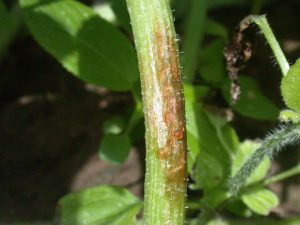
Features:
Gummy Stem Blight, caused by the fungus Didymella bryoniae, is a destructive disease affecting watermelon and other cucurbits. The pathogen can infect all above-ground parts of the plant, including leaves, stems, and fruit. Gummy Stem Blight thrives in warm, wet conditions and can persist in infected plant debris and seeds, making it a recurring problem in fields with a history of the disease.
Symptoms:
Symptoms of Gummy Stem Blight include water-soaked lesions on stems, leaves, and fruit. These lesions eventually turn brown or black and may produce a gummy, amber-colored exudate, hence the name “Gummy Stem Blight.” On leaves, the lesions are often circular and may have a tan center with a dark border. As the disease progresses, infected areas may become necrotic and lead to defoliation. Infected stems may crack, girdle, and collapse, leading to plant death. Fruit lesions are sunken, with a soft, decayed appearance, often rendering the fruit unmarketable.
Management:
Effective management of Gummy Stem Blight involves several strategies. Use disease-resistant varieties and ensure proper crop rotation with non-cucurbit crops to reduce pathogen load in the soil. Remove and destroy infected plant debris and weeds that may harbor the fungus. Fungicide applications, particularly protectant fungicides, can help manage the disease, especially during periods of wet, humid weather. Ensure adequate air circulation through proper plant spacing and trellising to reduce leaf wetness and humidity levels. An IPM approach that integrates these cultural, biological, and chemical controls is essential for managing Gummy Stem Blight in watermelon crops.
Solution:
Gummy Stem Blight is a damaging fungal disease that affects the stems and leaves of crops, leading to dark lesions, wilting, and even plant death. To effectively manage this disease, the use of Trianum Shield, a bio-fungicide based on Trichoderma harzianum, is highly recommended. This bio-fungicide colonizes the root zone, enhancing the plant’s resistance to pathogens like those causing Gummy Stem Blight. Trianum Shield not only suppresses the disease but also promotes healthier plant growth, allowing for a more resilient and productive crop without the need for chemical fungicides.
Bacterial Fruit Blotch
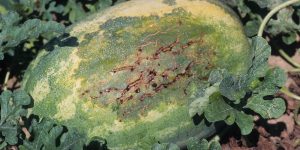
Features:
Bacterial Fruit Blotch (BFB) is caused by the bacterium Acidovorax avenae subsp. citrulli. This disease primarily affects watermelon fruit, causing significant economic losses due to fruit rot. BFB is most prevalent in warm, humid conditions and can spread rapidly under favorable conditions. The bacterium can be seed-borne, making it essential to use certified, disease-free seeds.
Symptoms:
Symptoms of Bacterial Fruit Blotch typically appear as dark, water-soaked lesions on the surface of the fruit, which expand rapidly and become sunken. The affected areas may crack, leading to secondary infections. Infected fruits often develop a greasy appearance and a foul odor as the flesh rots. On leaves, BFB can cause small, water-soaked spots that are less noticeable but can contribute to the spread of the bacteria. The disease can severely reduce marketable yields and cause substantial financial losses.
Management:
Managing Bacterial Fruit Blotch involves a combination of cultural, chemical, and biological practices. Start by using certified, disease-free seeds and avoid overhead irrigation to reduce leaf wetness. Crop rotation with non-host plants can help reduce the presence of the bacterium in the soil. Remove and destroy infected plant debris to prevent the spread of bacteria. Chemical control with copper-based bactericides can help manage BFB, particularly during periods of high humidity. Implementing an IPM approach that integrates these strategies is essential for effectively managing Bacterial Fruit Blotch in watermelon crops.
Solution:
Bacterial Fruit Blotch is a destructive bacterial disease that affects fruits, leading to water-soaked lesions, cracked skins, and significant crop loss. A practical and eco-friendly way to control this disease is by using Bacillus Polymyxa, a bactericide designed to suppress bacterial infections in plants. Bacillus Polymyxa works by targeting the bacteria responsible for the disease while promoting the plant’s overall health and resilience. With its natural composition, Bacillus Polymyxa offers an effective solution for controlling Bacterial Fruit Blotch, allowing you to protect your crops without resorting to harsh chemical treatments.
Alternaria Leaf Spot, watermelon leaf disease
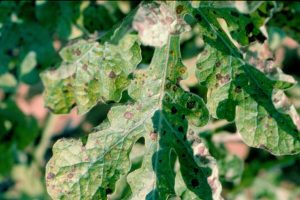
Features:
Alternaria Leaf Spot, caused by Alternaria cucumerina, is a fungal disease affecting watermelon and other cucurbits. It thrives in warm, humid conditions and can cause significant defoliation, reducing photosynthetic capacity and yield. The fungus is primarily spread by wind and water splash, and it can survive on infected plant debris in the soil.
Symptoms:
Symptoms of Alternaria Leaf Spot begin as small, circular, water-soaked lesions on the leaves, which enlarge and develop a tan or brown center with a dark border. These spots often have a characteristic target-like appearance with concentric rings. As the disease progresses, the infected leaves may yellow, wilt, and drop prematurely, exposing the fruit to sunscald and reducing overall plant vigor and yield.
Management:
Effective management of Alternaria Leaf Spot involves cultural practices and chemical controls. Ensure good air circulation through proper spacing and trellising to reduce leaf wetness and humidity levels. Rotate crops with non-cucurbit plants to reduce pathogen build-up in the soil. Remove and destroy infected plant debris to minimize the spread of the fungus. Fungicide applications can help manage Alternaria Leaf Spot, particularly during wet, humid conditions. An IPM approach that combines these methods is the most effective strategy for managing Alternaria Leaf Spot in watermelon crops.
Solution:
Alternaria Leaf Spot is a common fungal disease that causes dark spots and lesions on leaves, leading to premature defoliation and reduced crop yield. To address this issue, applying Trianum-V, a bio-fungicide containing Trichoderma harzianum, is a highly effective solution. Trianum-V works by colonizing the leaf surface and outcompeting the Alternaria pathogens, thereby reducing the severity of the disease. It also enhances the plant’s natural defense mechanisms, promoting healthier and more resilient crops. With Trianum-V, you can manage Alternaria Leaf Spot sustainably, avoiding the need for chemical fungicides.
Angular Leaf Spot
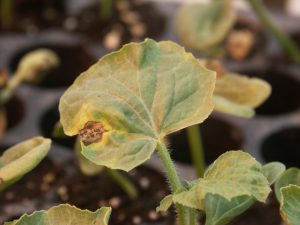
Features:
Angular Leaf Spot is a bacterial disease caused by Pseudomonas syringae pv. lachrymans. It affects watermelon and other cucurbits, particularly in areas with frequent rainfall or heavy dew. The bacterium is spread through water splash, infected seed, and contaminated tools or hands. It can cause significant defoliation and reduce fruit quality and yield.
Symptoms:
Symptoms of Angular Leaf Spot include small, water-soaked lesions on the leaves that become angular and are restricted by leaf veins. These lesions can turn brown and necrotic as they age, leading to leaf curling and defoliation. Infected fruit may exhibit small, water-soaked spots that can enlarge and cause the fruit to crack and rot. The disease is most severe during wet, humid conditions and can spread rapidly under favorable conditions.
Management:
Managing Angular Leaf Spot requires a combination of cultural practices and chemical controls. Use certified, disease-free seeds and avoid overhead irrigation to reduce leaf wetness. Regularly inspect plants for early signs of infection and remove and destroy infected leaves to prevent the spread of bacteria. Copper-based bactericides can be effective in managing Angular Leaf Spot, especially during periods of wet, humid weather. Implementing an IPM strategy that integrates these methods is essential for effectively managing Angular Leaf Spot in watermelon crops.
Solution:
Angular Leaf Spot is a bacterial disease that causes angular, water-soaked lesions on leaves, eventually leading to defoliation and reduced plant vigor. A natural and effective way to manage this disease is by applying Bacillus subtilis, beneficial bacteria that act as bio-fungicides. These bacteria colonize the plant surfaces, preventing the spread of the Angular Leaf Spot bacteria by outcompeting them for space and nutrients. By using Bacillus amyloliquefaciens, you create a protective barrier that promotes healthier plants and controls the disease without relying on chemical treatments.
Phytophthora Blight
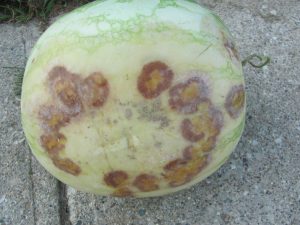
Features:
Phytophthora Blight, caused by Phytophthora capsici, is a serious soil-borne disease affecting watermelon and other cucurbits. It thrives in wet, poorly drained soils and can cause rapid wilting and plant death. The pathogen infects roots, stems, and fruit, leading to severe crop losses if not managed properly.
Symptoms:
Symptoms of Phytophthora Blight include dark, water-soaked lesions on stems and fruit, which can rapidly expand and cause the affected tissue to rot. Infected plants may exhibit wilting, yellowing, and dieback, particularly during hot, humid weather. The fruit can become soft and watery, developing a characteristic white mold on the surface. In severe cases, entire fields may be affected, resulting in total crop loss.
Management:
Managing Phytophthora Blight involves several strategies. Improve soil drainage and avoid over-irrigation to reduce the risk of disease development. Use resistant varieties when available and rotate crops with non-host plants to reduce pathogen build-up in the soil. Apply fungicides as a preventive measure, particularly during periods of wet weather. Ensure proper field sanitation by removing and destroying infected plant debris. An IPM approach that incorporates these cultural, biological, and chemical controls is essential for managing Phytophthora Blight in watermelon crops.
Solution:
Phytophthora Blight is a severe fungal disease that causes stem rot, leaf blight, and fruit decay, significantly damaging crops. An effective and sustainable solution for managing this disease is the use of Trichoderma harzianum. These beneficial fungi act as bio-fungicides, colonizing the root zone and outcompeting the Phytophthora pathogens, while also enhancing the plant’s immune system. By applying these Trichoderma species, you protect your crops from Phytophthora Blight, fostering healthier growth and reducing the need for chemical fungicides.
Root Knot Nematodes
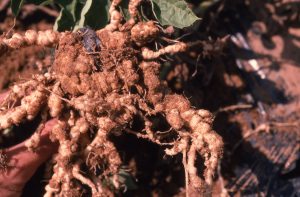
Features:
Root Knot Nematodes, primarily Meloidogyne spp., are microscopic roundworms that attack the roots of watermelon plants, causing significant yield losses. These nematodes thrive in warm, sandy soils and can survive for many years in the absence of a host. They are most problematic in fields with a history of nematode infestations.
Symptoms:
Symptoms of Root Knot Nematode infestation include the formation of galls or swellings on the roots, which can reduce the plant’s ability to uptake water and nutrients. Affected plants often exhibit stunted growth, yellowing, and wilting, especially during hot weather. Fruit yield is typically reduced, and the fruit may be smaller and of lower quality. In severe cases, entire plants may die.
Management:
Effective management of Root Knot Nematodes involves a combination of cultural, chemical, and biological practices. Rotate crops with non-host plants to reduce nematode populations in the soil. Use resistant varieties when available and improve soil health with organic amendments, such as compost or cover crops, to enhance beneficial microbial activity. Soil solarization can help reduce nematode populations by heating the soil to lethal temperatures. Chemical nematicides can be effective but should be used as part of an IPM strategy that integrates cultural and biological controls for sustainable management.
Solution:
Root Knot Nematodes are parasitic pests that cause swollen, knotted roots, leading to stunted plant growth and reduced yield. A powerful solution to this problem is the use of Nema Pro and Nema ProMax , bio-nematicides designed to target and suppress nematode populations. These products contain beneficial microbes that parasitize nematodes, reducing their impact on the plant’s root system while promoting overall soil health. By using Nema Pro or Nema ProMax, you can effectively control Root Knot Nematodes without relying on harsh chemical treatments, ensuring healthier roots and more vigorous crop growth.
Pythium Damping-Off
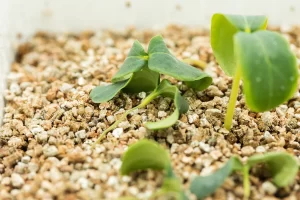
Features:
Pythium Damping-Off, caused by Pythium spp., is a common soil-borne disease that affects watermelon seedlings, leading to poor stand establishment and reduced yield. The disease is most severe in cool, wet conditions and can affect seedlings both before and after emergence.
Symptoms:
Symptoms of Pythium Damping-Off include seed rot, poor germination, and seedling collapse. Infected seedlings may appear water-soaked, wilted, and discolored at the soil line. The stems often become thin and weak, causing the seedlings to collapse and die. In post-emergence damping-off, older seedlings may develop root rot, resulting in stunted growth and reduced vigor.
Management:
Managing Pythium Damping-Off involves several strategies. Use high-quality, treated seeds and avoid planting in cold, wet soils. Ensure proper soil drainage and avoid overwatering to reduce the risk of disease development. Fungicide seed treatments can help protect seedlings from infection, especially in fields with a history of damping-off. Crop rotation with non-host plants and improving soil health with organic amendments can also help reduce Pythium populations. An IPM approach that integrates these methods is essential for managing Pythium Damping-Off in watermelon crops.
Solution:
Pythium Damping-Off is a destructive disease that affects seedlings, causing root rot and stem collapse, often leading to plant death. A highly effective and natural way to manage this disease is the application of Trianum Shield , a bio-fungicide based on Trichoderma harzianum. This beneficial fungus colonizes the root zone, outcompeting Pythium pathogens and creating a protective barrier around the roots. With Trianum Shield , you can prevent Pythium Damping-Off while promoting stronger, healthier seedlings, all without the need for chemical fungicides.
Verticillium Wilt

Features:
Verticillium Wilt, caused by Verticillium dahliae, is a soil-borne fungal disease that affects watermelon and many other crops. The fungus infects the plant through the roots and spreads throughout the vascular system, causing wilting and plant death. The disease is most severe in cool, wet conditions and can persist in the soil for many years.
Symptoms:
Symptoms of Verticillium Wilt include yellowing and wilting of leaves, often starting with the older leaves and progressing upwards. Affected plants may exhibit stunted growth and reduced vigor. Cutting open the stems reveals brown streaks in the vascular tissue, a characteristic sign of this disease. In severe cases, the plant may collapse and die, significantly reducing yield.
Management:
Managing Verticillium Wilt requires an integrated approach. Use resistant varieties and practice crop rotation with non-host plants to reduce pathogen levels in the soil. Avoid planting in fields with a history of Verticillium Wilt, and improve soil health with organic amendments to enhance beneficial microbial activity. Fungicides are generally not effective once the disease is established, so focus on preventive measures. Implementing an IPM approach that integrates these strategies is essential for managing Verticillium Wilt in watermelon crops.
Solution:
Verticillium Wilt is a soil-borne fungal disease that causes yellowing, wilting, and eventual plant death by blocking water flow through the plant’s vascular system. A natural and effective way to combat this disease is by using Cropium, an organic fungicide based on Penicillium bilaiae. This beneficial fungus promotes healthier root development while competing with Verticillium pathogens in the soil, reducing the disease’s impact. By applying Cropium, you protect your plants from Verticillium Wilt and enhance overall crop resilience, without the need for chemical fungicides.
Soil health management in watermelon farm
So in this respect, it can therefore be concluded that quality of the soil is a measure of wellbeing in the production of watermelons based on the way it influences the manner in which the plants grow, the quality of the fruits and the resistance of the crops. These are some of the requirements that are suitable for watermelon production: Watermelon plants need a good soil that has proper nutrients and the plants should not be infected with disease.
In order to improve soil quality, Novobac avails organic amendments that will help in the availability of nutrients as well as the microbial population in soils and general plant health.
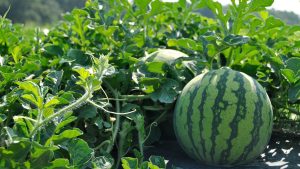
Metilo:
This specialised organic matter is particularly useful for enhancing the nutrient status within this natural body through stimulation of diverse biochemical processes in the soil. Soil structure is formed, organic matter begins to appear, and required nutrients for roots and melons development for your watermelon are provided.
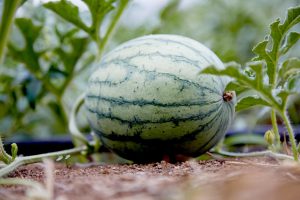
Soil Vigor:
It also performs the function of the accelerator which exerts certain pressure on biological processes and the stimulator which creates nutrient turnover in the soil. It decomposes organic matter, enhances the physical properties of the soil, thus appropriate for watermelon farms that encounter dry or compacted soils.
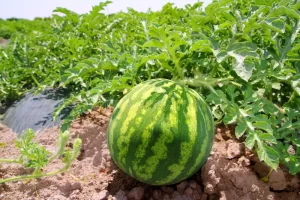
Cropium:
This fungicide developed from Penicillium bilaiae not only targets soil borne diseases but also improves root health. Cropium facilitates phosphorus uptake which in turns helps watermelon to establish a good root system and quality fruits and also overcome diseases affects.
In this case the application of Metilo, Soil Visor, and Cropium in the management of soils offer watermelons the best environment as well as nutrients for growth and production without using those injurious killer chemicals.
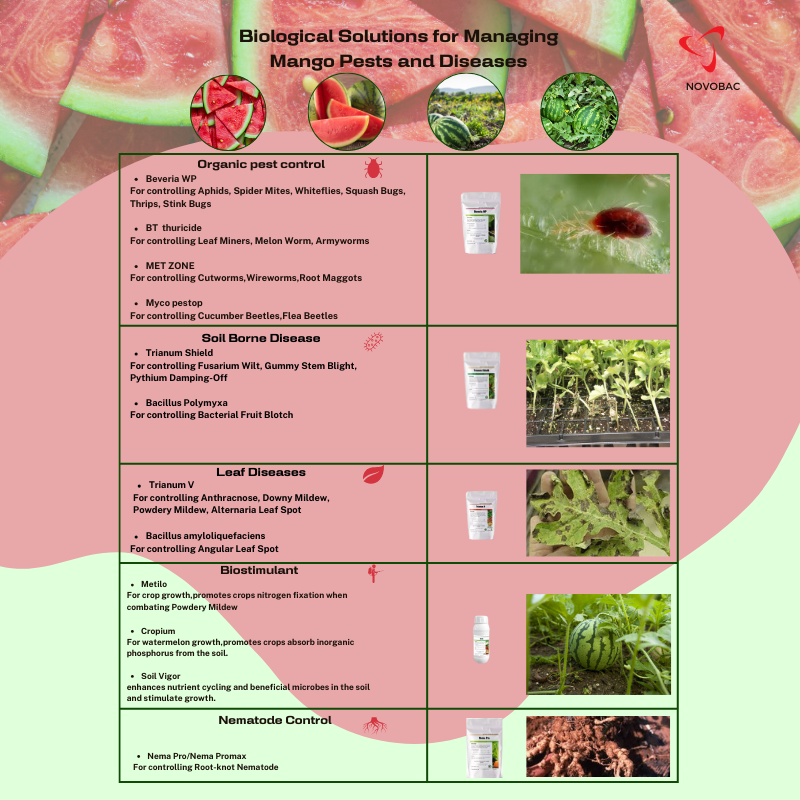
Related Products
CONTACT US

Office 38/1502, No 660,Hanguang Rt., Changsha City, Hunan, China



































